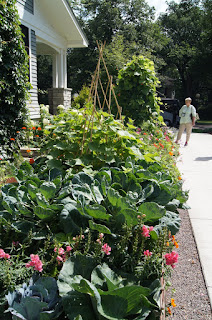Most basic was plant choices. Xeriscape, a water-conscious approach to garden design, provides guidelines for selecting plants that don’t need supplemental watering. Some tips: smaller leaves generally need and lose less water, grayish or fuzzy foliage usually means a plant is drought-tolerant, low-growing plants avoid drying winds, and plants with a scent, such as lavender, produce aromatic oils that help plants hold onto water. I did end up with some plants with each of these characteristics, but not out of any conscious plan.
 |
| Gray, fuzzy leaves of lambs' ears (Stachys byzantina) conserve water |
Next, I should have grouped plants based on their water needs. Putting thirsty hydrangeas next to water-sipping catmint, with its small gray leaves, might have looked nice, but it meant I under-watered the hydrangeas and probably used more water on catmint than it needed—though it didn’t complain.
 |
| Hydrangeas need a lot of water |
Then there was my choice of irrigation method.
 |
| Sprinklers lose water to evaporation |
The sprinkler system we installed was standard for our city, but I could have saved on evaporation by using soaker hoses, which sweat droplets of water, or drip irrigation, with small emitters that deliver water precisely to the spot its needed at the base of a tree or shrub.
My rain barrel is a small step toward collecting rain to irrigate the garden.
 |
| The rain barrel is great--when it rains |
I wish I’d thought to install an underground cistern to store all the rainwater that falls on the roof before I planted my garden. If I had, in an average year the cistern could have supplied my garden’s irrigation needs. This is certainly not an average year, though. To irrigate with rainwater, you have to have rain, and this year that’s been scarce.
So at this point, my garden is looking sad and parched.
 |
| A forsythia wilting outside the range of the irrigation sprinklers |
With a guilty conscience, I supplement scheduled irrigation from the sprinkler system with evening use of a rotating sprinkler to revive wilting plants in areas the automatic system misses (evening watering is recommended to minimize evaporation).
We get our water from the Quabbin and Wachusett reservoirs in western Massachusetts, and our water authority hasn’t imposed a watering ban so far. Not so lucky are gardeners whose water comes from town supplies, nearby rivers, or wells on their own property. I can only imagine how painful it would be to watch cherished plantings die from lack of water.
If I ever build a new house, I’ll put in that underground rainwater cistern before I start planting, and I’ll push for a graywater system too. That would collect water from sinks, dishwasher, clothes washer, and shower to reuse for irrigation. The city of Las Vegas has this all worked out long since.
In the meantime, I’ll make sure I dump water from the sink on garden beds when I can instead of letting it flow down the drain, and I’ll think about less lawn and more drought-tolerant native plants for next year.
 |
| Cucumbers on the deck benefit from any spare water from the sink |




















